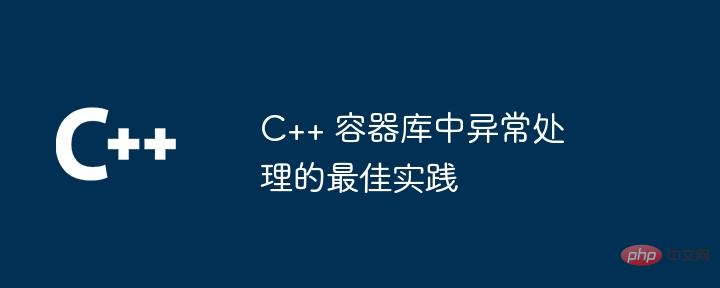
In C++ container libraries, best practices for exception handling include: handling exceptions explicitly (using try-catch blocks), using noexcept declarations (for operations that do not throw exceptions), and utilizing standard exception types (such as std:: out_of_range), use global exception handlers with caution. These measures ensure that the application is robust and maintainable.

Best practices for exception handling in C++ container libraries
When using C++ container libraries, handling errors and exceptions is crucial important. By adopting best practices, you can ensure that your application is robust and maintainable.
1. Explicit error handling
try-catch blocks to explicitly handle potential exceptions. **`cpp
try {
// Container operation
} catch (const std::exception& e) {
std: :cerr << "Exception occurred:" << e.what() << std::endl;
}
**2. 使用 `noexcept` 申明** * 对于不抛出异常的操作,请使用 `noexcept` 申明。 * 这将提高代码的可读性和效率,因为编译器可以优化异常处理。 **```cpp std::vector<int> my_vector; my_vector.push_back(10); // noexcept
3. Using standard exception types
Take advantage of container-specific exception types provided by the C++ standard library, for example:
std::bad_allocstd::out_of_rangestd::invalid_argument** `cpp
try {
std::vector
my_vector.at(100); // throw std::out_of_range
} catch (const std:: out_of_range& e) {
// Handling exceptions
}
**4. 谨慎使用全局异常处理程序**
* 虽然全局异常处理程序可能很方便,但它们可以使调试变得困难。
* 除非特定需要,否则避免使用它们。
**实战案例**
以下是使用上述最佳实践处理容器库异常的示例:
**```cpp
std::vector<std::string> names;
// 使用 try-catch 块
try {
names.at(5); // 可能会抛出 std::out_of_range
} catch (const std::out_of_range& e) {
std::cerr << "索引超出范围:" << e.what() << std::endl;
}
// 使用 noexcept 申明
std::vector<int> numbers(10, 0); // noexcept
// 使用特定于容器的异常类型
try {
numbers.reserve(20); // 可能会抛出 std::bad_alloc
} catch (const std::bad_alloc& e) {
std::cerr << "内存不足:" << e.what() << std::endl;
}By following these best practices, you can effectively handle exceptions in your C++ container library, thereby improving application stability and maintenance sex.
The above is the detailed content of Best practices for exception handling in C++ container libraries. For more information, please follow other related articles on the PHP Chinese website!
 What are the differences between c++ and c language
What are the differences between c++ and c language
 Recommended learning order for c++ and python
Recommended learning order for c++ and python
 Cost-effectiveness analysis of learning python and c++
Cost-effectiveness analysis of learning python and c++
 Is c language the same as c++?
Is c language the same as c++?
 Which is better to learn first, c language or c++?
Which is better to learn first, c language or c++?
 The difference and connection between c language and c++
The difference and connection between c language and c++
 C++ software Chinese change tutorial
C++ software Chinese change tutorial
 Cost-effectiveness analysis of learning python, java and c++
Cost-effectiveness analysis of learning python, java and c++




